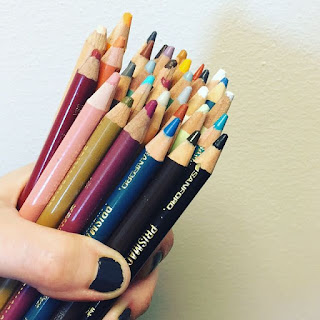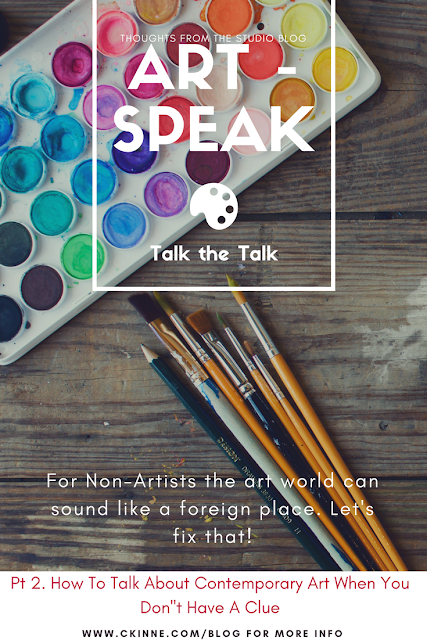How I Paint with Colored Pencils
A few weeks ago I attended an in-person event where I was working on of my recent portrait pieces. And one comment came up over and over again as visitors came by my work table. They were shocked to see that my works were made, not with paint, but with colored pencils.
While there is some debate over this in the art world, I consider my recent colored pencil works to be paintings. Though not made with traditional paint material such as oils, watercolors or acrylics, much of my process in working with the colored pencil mimics that of the painting process.
 | |
| Colored Pencil Painting in Process, laying in base tones. |
Process:
Much like when starting a paining I make a delicately light (tradition No. 2) pencil outline drawing on to the work surface (most recently: wood panels).
Then, using a kneaded eraser, I erase much of the outline sketch so that only the faintest indication is left. Just as if i were using paint, I do not want my lighter colored, colored pencils to mix with the graphite and alter the end result. Next, I block in base-tones using the burnishing technique. This is a colored pencil technique in which heavy pressure is applied so that pigment is laid down so that it looks opaque. Once I have the mid-tones down I go back in with the use of shading and highlighting techniques to help create the illusion of form by adding more value (differences in light-dark). I use wax based colored pencils which actually enable me to do blending of colors just as you would blend wet paint on a canvas. Once this is complete, I go it and add the fine, smaller details and add definition. I, personally, save the cast shadow for last. I do not use the heavy-handed burnishing technique here, instead of letting some of the ground surface show through the pigment. This is done purposely so that the case shadow has a transparent feel to it, just as a real shadow does. The last step in my colored pencil painting process is to coat it with a layer of varnish. I use a spray varnish to get a nice, quick, even coat. Not only does this help seal in the pigment and prevent any possible smudging, but also it helps prevent against wax bloom- a wax-based colored pencil pencil phenomenon in which a hazy film forms over the pigment applied to the artwork, especially in areas where burnishing was applied. Once my piece has been varnished, it is ready for the coat of resin, but that is a whole other process I'll save for another time. So there you have it, how I make paintings with colored pencils!
Much like when starting a paining I make a delicately light (tradition No. 2) pencil outline drawing on to the work surface (most recently: wood panels).
Then, using a kneaded eraser, I erase much of the outline sketch so that only the faintest indication is left. Just as if i were using paint, I do not want my lighter colored, colored pencils to mix with the graphite and alter the end result. Next, I block in base-tones using the burnishing technique. This is a colored pencil technique in which heavy pressure is applied so that pigment is laid down so that it looks opaque. Once I have the mid-tones down I go back in with the use of shading and highlighting techniques to help create the illusion of form by adding more value (differences in light-dark). I use wax based colored pencils which actually enable me to do blending of colors just as you would blend wet paint on a canvas. Once this is complete, I go it and add the fine, smaller details and add definition. I, personally, save the cast shadow for last. I do not use the heavy-handed burnishing technique here, instead of letting some of the ground surface show through the pigment. This is done purposely so that the case shadow has a transparent feel to it, just as a real shadow does. The last step in my colored pencil painting process is to coat it with a layer of varnish. I use a spray varnish to get a nice, quick, even coat. Not only does this help seal in the pigment and prevent any possible smudging, but also it helps prevent against wax bloom- a wax-based colored pencil pencil phenomenon in which a hazy film forms over the pigment applied to the artwork, especially in areas where burnishing was applied. Once my piece has been varnished, it is ready for the coat of resin, but that is a whole other process I'll save for another time. So there you have it, how I make paintings with colored pencils!
To check out this process in action, join me on my Facebook page, at 5:30pm EST on the second of every month for my Seconds in the Studio series where I stream live while I work in my studio.
Like this post? Join my email list so that you can stay up today on future blog posts by clicking here
Click here to return to my full website.
Click here to return to my full website.



Comments
Post a Comment